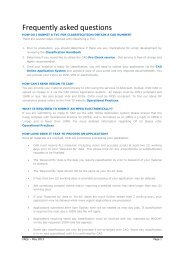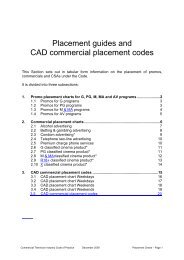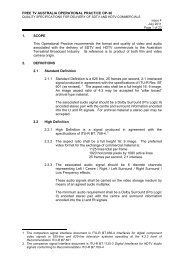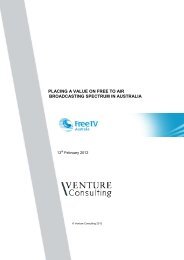FREE TV AUSTRALIA OPERATIONAL PRACTICE OP-20 1. SCOPE ...
FREE TV AUSTRALIA OPERATIONAL PRACTICE OP-20 1. SCOPE ...
FREE TV AUSTRALIA OPERATIONAL PRACTICE OP-20 1. SCOPE ...
You also want an ePaper? Increase the reach of your titles
YUMPU automatically turns print PDFs into web optimized ePapers that Google loves.
<strong>FREE</strong> <strong>TV</strong> <strong>AUSTRALIA</strong> <strong><strong>OP</strong>ERATIONAL</strong> <strong>PRACTICE</strong> <strong>OP</strong>-<strong>20</strong><br />
FILM TO TAPE TRANSFERS Issue 1<br />
June 1986<br />
Page 1 of 11<br />
<strong>1.</strong> SC<strong>OP</strong>E<br />
This document recommends the format and technical characteristics for programs transferred<br />
from film to PAL 25.4mm ‘C’ format Videotape.<br />
The basic film transfer requirement is PAL Telecine to PAL Videotape at 25 frames per<br />
second. Film scanning hardware should be either a flying spot or CCD equipment. The<br />
resultant videotape should be only one generation removed from the final compiled master.<br />
The resultant software should be of broadcast quality and capable of being transmitted<br />
without any further processing of picture or sound - this implies:<br />
a) A programmed telecine transfer of satisfactory and consistent scene by scene<br />
picture quality.<br />
b) A sound recording of suitable quality and dynamic range appropriate for<br />
television broadcast (Appendix A.2.2 Audio)<br />
2. TAPE FORMAT<br />
2.1 The tape format is 25.4mm helical-scan, non-segmented field EBU format 'C' as<br />
described in the applicable section of EBU Technical Information sheet No. 7.<br />
2.2 Stereo program sound should be supplied with left channel on Track 1 and right<br />
channel on Track 2. Monaural programs should be supplied with two track mono,<br />
Tracks 1 and 2.<br />
2.3 EBU timecode should be carried as a VITC on lines 18 (331) and <strong>20</strong> (333) of the<br />
vertical interval and longitudinal time code on Audio Track 3 in accordance with<br />
EBU technical document 3097 Edition 3.<br />
2.4 The pre-program test section should be in accordance with Free <strong>TV</strong> Australia<br />
Operational Practice <strong>OP</strong> 10.<br />
3. PROGRAM MATERIAL<br />
3.1 Program original material should be from the highest quality source available; where<br />
possible this should be 35mm positive film for the image and separate magnetic tape<br />
for the audio.<br />
Mediums for transfer in order of preference are:<br />
a) 35mm - Interpositive and Separate Magnetic Sound.<br />
b) 35mm - Low Contrast. Release Print with Separate Magnetic Sound.<br />
c) 35mm - Low Contrast. Release with Optical Sound.
<strong>FREE</strong> <strong>TV</strong> <strong>AUSTRALIA</strong> <strong><strong>OP</strong>ERATIONAL</strong> <strong>PRACTICE</strong> <strong>OP</strong>-<strong>20</strong><br />
FILM TO TAPE TRANSFERS Issue 1<br />
June 1986<br />
Page 2 of 11<br />
d) 35mm - Projection Contrast. Release Print.<br />
e) Other material by prior arrangement.<br />
3.2 If material was originally produced with stereo sound, a stereo transfer should be<br />
provided. The stereo mix should be equivalent to that on a stereo variable area 2 track<br />
master (i.e. centre and surround information contained within stereo left and right<br />
tracks to produce a "phantom" centre channel).<br />
3.3 A composite audio mix should be provided, not separate M and E and dialogue tracks.<br />
3.4 Any horizontal and vertical instability of the image should not be less than 0.1% of<br />
picture height. The rate of picture movement should not be subjectively annoying.<br />
Any variation from this should be infrequent and of short duration.<br />
The film print should be clean and free of both surface and printed dirt and should be<br />
free of emulsion or base side damage.<br />
4. VIDEO FORMAT<br />
4.1 Video signals shall be 625 line/50 field per second PAL format, with sync. and<br />
blanking in accordance with CCIR recommendation 472-1 and the specification given<br />
in CCIR Report 624-1 which apply to color video signals for use in PAL B, G, H or I<br />
television systems.<br />
4.2 Insertion Test Signals (ITS) should originate at the Telecine and should not be deleted<br />
at any stage i.e. they should appear on the release copy. ITS signals on lines 17 and<br />
330 should be those recommended by the CCIR for international program exchange<br />
viz:<br />
Line 17 - Luminance bar, 2T pulse, composite <strong>20</strong>T pulse, 5 riser luminance<br />
staircase without subcarrier.<br />
Line 330 - Luminance bar, 2T pulse, 5 riser staircase with subcarrier.<br />
5. AUDIO FORMAT<br />
5.1 Mono. audio material should be recorded on both Tracks 1 and 2. Recordings with<br />
dissimilar audio on Tracks 1 and 2 are not desirable (except stereo).<br />
5.2 Stereo shall be recorded with the left channel on Track 1 and the right channel on<br />
Track 2. Left and right channels shall be recorded in phase from line up signals to<br />
end of program.<br />
5.3 Program audio should not be companded except by prior arrangement in which case it<br />
should Dolby A.
<strong>FREE</strong> <strong>TV</strong> <strong>AUSTRALIA</strong> <strong><strong>OP</strong>ERATIONAL</strong> <strong>PRACTICE</strong> <strong>OP</strong>-<strong>20</strong><br />
FILM TO TAPE TRANSFERS Issue 1<br />
June 1986<br />
Page 3 of 11<br />
5.4 The audio recording must be in sync. with the vision (limit ± 1 frame).<br />
5.5 0dBmOs alignment level must be equivalent to a flux level of 100nWb/M.<br />
6. TAPE MACHINE COMPATIBILITY<br />
Compatibility of record/replay machines requires the following:<br />
6.1 The tape must be recorded under conditions such that it can be satisfactorily replayed<br />
on any 25.4mm 'C' format machine aligned to its manufacturer's specifications.<br />
6.2 The record machine shall use video heads designed for the EBU 'C' format.<br />
6.3 The color frame pulse must appear on Field <strong>1.</strong><br />
6.4 The first four broad segments of the vertical sync. must be recorded. The RF<br />
envelope should be flat and of high amplitude.<br />
6.5 Relative phase error between audio Tracks 1 and 2 should not exceed 5° at 3KHz and<br />
30° at 15 KHz.<br />
7. SUBJECTIVE PICTURE AND SOUND QUALITY<br />
Luminance Quality<br />
7.1 Picture black level should appear to be correct, free of noticeable black crushing,<br />
compression or clipped dark areas.<br />
7.2 Low key scenes should have sufficient contrast and APL (average picture level) to<br />
appear acceptable under normal viewing conditions.<br />
7.3 Picture white areas, where detail is required, should appear normal and free of<br />
noticeable highlight compression.<br />
7.4 Transient response should be crisp and clean, free of noticeable horizontal and<br />
vertical pre-shoot, over-shoot, smear, ringing, echoes (ghosts) and afterglow errors.<br />
8. SOUND QUALITY<br />
8.1 Overall sound quality should be pleasing and free of noticeable noise or spurious<br />
signals (e.g. hum, buzz, distortion, wow, flutter, distortion or excessive sibilants).<br />
(See Appendix E.)<br />
8.2 Tonal balance, bass to mid range to treble, should be pleasing and believable.<br />
8.3 Stereo program should have correct left-right relationship between picture and sound.
<strong>FREE</strong> <strong>TV</strong> <strong>AUSTRALIA</strong> <strong><strong>OP</strong>ERATIONAL</strong> <strong>PRACTICE</strong> <strong>OP</strong>-<strong>20</strong><br />
FILM TO TAPE TRANSFERS Issue 1<br />
June 1986<br />
Page 4 of 11<br />
8.4 Left and right stereo audio channels should be in-phase from beginning to end of tape.<br />
9. MONITORING AND CONTROL<br />
This section specifies the conditions of monitoring which will be used to assess the program<br />
technical quality.<br />
9.1 The color monitor will be at least 50cm diagonal in size and mounted in an<br />
illuminated surround in accordance with EBU/SMPTE recommendations. The<br />
monitor will be grade 1 PAL monitor with a picture tube using standard EBU<br />
phosphors.<br />
9.2 The monitor will be adjusted for grey scale tracking so as to produce illuminant D<br />
(6,500K) from black to white. A known optical source of illuminant D will be used as<br />
a reference for calibration, e.g. a "Grafikon" source.<br />
9.3 The monitor will be adjusted to produce 25 foot lamberts brightness on peak white<br />
signal. The black brightness will be set with a PAL "Pluge" or similar signal. The<br />
chroma level will be set accurately by use of a test signal intended for that purpose<br />
(e.g. Philips PM5544 test pattern)<br />
9.4 The illuminated surround will be of a size and will produce illuminant D at a<br />
brightness level as recommended by EBU/SMPTE. The monitor will be viewed at a<br />
distance of approximately 5 times the picture height.<br />
9.5 If dual standard monitors are used for monitoring the PAL signal, care will be<br />
exercised in the line up of the black brightness. (The PAL signal does not employ<br />
7 1/2 IRE units of set up. Reference black in PAL is zero IRE.)<br />
Audio Monitoring:<br />
The audio will be monitored in a quiet environment using two separate loudspeaker systems.<br />
One will be a quality sound monitor, the other representative of a home receiver. The audio<br />
will be monitored at an appropriate sound level so as to be consistent with the home<br />
environment.<br />
10. ASSESSMENT OF QUALITY<br />
The technical quality will be assessed in accordance with the following criteria:<br />
10.1 The whites (highlights) and deep shadows should be neutral at approximately<br />
illuminate D, i.e. zero sub-carrier at highlights and deep shadows.<br />
10.2 The shadow detail should be maximised consistent with the overall graduation<br />
characteristics. On an average scene, this will tend to distribute the video content<br />
evenly over the black and white range. The telecine should be able to maintain its<br />
minimum gamma value law over a contrast range of at least 150 to <strong>1.</strong> (Care of the
<strong>FREE</strong> <strong>TV</strong> <strong>AUSTRALIA</strong> <strong><strong>OP</strong>ERATIONAL</strong> <strong>PRACTICE</strong> <strong>OP</strong>-<strong>20</strong><br />
FILM TO TAPE TRANSFERS Issue 1<br />
June 1986<br />
Page 5 of 11<br />
telecine optical system is important in maintaining good contrast handling and stable<br />
black levels.)<br />
10.3 The overall color balance of normal scenes should produce the impression of scenes<br />
illuminated by light of approximately illuminate D. The skin tones should always be<br />
of a believable hue and a believable level of saturation irrespective of what racial<br />
group is being portrayed. As a guide the average Caucasian skin tone tends to have<br />
the hue and amplitude of the positive burst vector of a PAL signal.<br />
10.4 Contour correction. The pictures should have the appearance of subtle sparkle or<br />
crispness due to just the right amount of contour correction - the vertical and<br />
horizontal edges should be equal and not exaggerated. It is possible to trade a small<br />
amount of film grain to achieve the above subtle sparkle or crispness.<br />
10.5 Monochrome material should have no color tint.<br />
1<strong>1.</strong> TELECINE PERFORMANCE<br />
1<strong>1.</strong>1 The telecine performance should not be less than that indicated in A4. The two<br />
following paragraphs refer to flying spot scanners.<br />
1<strong>1.</strong>2 The scanning tube should be free of all blemishes as per the specification for Rank<br />
Cintel 1855 X 3 tubes.<br />
1<strong>1.</strong>3 The after glow corrector should be correctly aligned, with no noticeable neutral or<br />
color streaking.<br />
1<strong>1.</strong>4 The horizontal aperture corrector setting should give at least 100% depth of<br />
modulation at 400 lines*. The contour correction should be set subjectively - with a<br />
minimum amount of coring used and little visible enhancement of film grain. The<br />
amounts of vertical and horizontal contour correction should be equal.<br />
1<strong>1.</strong>5 Anamorphic transfers require that the horizontal corrector be reset for at least 100%<br />
depth of modulation at 600 lines* on the SMPTE resolution test film (<strong>TV</strong> 35-AR).<br />
1<strong>1.</strong>6 Auto color balance devices should not be employed.<br />
1<strong>1.</strong>7 Additional down stream noise reduction devices should not be used.<br />
1<strong>1.</strong>8 Limited AGC may be used so that densities between 0 and 0.5 will reproduce at 100%<br />
video level - however, the action of these circuits should be subtle.<br />
1<strong>1.</strong>9 Correct framing and full frame height and geometry should be maintained throughout<br />
the program.
<strong>FREE</strong> <strong>TV</strong> <strong>AUSTRALIA</strong> <strong><strong>OP</strong>ERATIONAL</strong> <strong>PRACTICE</strong> <strong>OP</strong>-<strong>20</strong><br />
FILM TO TAPE TRANSFERS Issue 1<br />
June 1986<br />
Page 6 of 11<br />
Note:<br />
Horizontal blanking and picture geometry should be achieved at the Telecine chain and not<br />
by any downstream digital video processing.<br />
12. ANAMORPHIC TRANSFERS<br />
12.1 The picture height should be set such that image occupies the full active vertical scan.<br />
The horizontal width should then be set for correct geometry.<br />
12.2 Panning and scanning of anamorphic prints should be pre-programmed. Visible<br />
picture disturbances caused by rapid panning should be minimised.<br />
* The resolution test film needs to be calibrated to allow for optical film losses.<br />
13. PROGRAM FORMAT<br />
13.1 Where possible, programs should be recorded continuously on a single tape with a<br />
maximum reel size of 29.85 cm (1<strong>20</strong> mins).<br />
13.2 Feature material should be recorded continuously without breaks.<br />
13.3 Material produced with built-in commercial breaks should be transferred with normal<br />
fade to black and immediate return to the next segment. Any integrations (e.g. "place<br />
commercial here") or sponsor credits should be deleted.<br />
13.4 Color burst should be present on all video tapes, whether the program material is<br />
color or monochrome.<br />
13.5 In general, the following should be avoided as they may result in rejection:<br />
a) Lack of continuity from one reel to the next reel e.g. overlapping of scenes.<br />
b) Tape dropouts that cannot be corrected by a dropout compensator circuit.<br />
c) Film edits or joins which cause a disturbance to the picture stability.<br />
d) Tape edits which do not maintain color frame continuity or control track and<br />
color frame pulse continuity.<br />
e) Tearing, jitter and/or other synchronisation defects.<br />
f) Visible streaking or afterglow.<br />
g) Changes of framing position during program time.
<strong>FREE</strong> <strong>TV</strong> <strong>AUSTRALIA</strong> <strong><strong>OP</strong>ERATIONAL</strong> <strong>PRACTICE</strong> <strong>OP</strong>-<strong>20</strong><br />
FILM TO TAPE TRANSFERS Issue 1<br />
June 1986<br />
Page 7 of 11<br />
h) Scratches, sprocket marks, dirt accumulation in the gate mechanism or on the<br />
face of the scanning tube.<br />
i) Chroma/burst phase errors greater than 10ø.<br />
j) Noticeable audio distortion, especially in the sibilant area; noticeable wow or<br />
flutter.<br />
k) Out of focus or "soft" images.<br />
l) Excessive telecine flare.<br />
m) Titles outside of safe title area.<br />
n) Over enhanced picture edges.<br />
o) Poor transient response.<br />
14. DOCUMENTATION<br />
14.1 The tape box, reel and clapper shall be labelled in accordance with Free <strong>TV</strong> Australia<br />
Operational Practice <strong>OP</strong>13.<br />
14.2 A cue sheet should be supplied showing times of segments and overall time in<br />
timecode notation. The cue sheet should also indicate any problems or unusual<br />
characteristics of the transfer.<br />
Appendix A<br />
This is not part of <strong>OP</strong><strong>20</strong> but is included to facilitate its use.<br />
A.1 PROBLEMS EXPERIENCED<br />
Some of the standard problems on material supplied to Free <strong>TV</strong> Australia members which we<br />
wish to overcome are:<br />
A.<strong>1.</strong>1 The use of photoconductive telecines.<br />
A.<strong>1.</strong>2 The use of standards converted film transfers.<br />
A.<strong>1.</strong>3 Soft pictures (focus).<br />
A.<strong>1.</strong>4 Poor shadow detail.<br />
A.<strong>1.</strong>5 Color in blacks and highlights.<br />
A.<strong>1.</strong>6 Blacks clipped into blanking or, black level too high (e.g. NTSC set up).
<strong>FREE</strong> <strong>TV</strong> <strong>AUSTRALIA</strong> <strong><strong>OP</strong>ERATIONAL</strong> <strong>PRACTICE</strong> <strong>OP</strong>-<strong>20</strong><br />
FILM TO TAPE TRANSFERS Issue 1<br />
June 1986<br />
Page 8 of 11<br />
A.<strong>1.</strong>7 Poor rendition of skin tones.<br />
A.<strong>1.</strong>8 Lack of telecine grading or inconsistent grading.<br />
A.<strong>1.</strong>9 Incorrect LF response, smear, badly adjusted afterglow.<br />
A.<strong>1.</strong>10 Incorrect HF response (ringing and overshoot).<br />
A.<strong>1.</strong>11 Noise due to excessive tape generations.<br />
A.<strong>1.</strong>12 Under enhanced pictures.<br />
A.<strong>1.</strong>13 Incorrect blanking.<br />
A.<strong>1.</strong>14 Compatibility problems between record/replay machines, e.g. tension and/or<br />
guide problems.<br />
A.<strong>1.</strong>15 Incorrect aspect ratio of picture.<br />
A.<strong>1.</strong>16 Worn/damaged film.<br />
A.<strong>1.</strong>17 Severe shading or fogging (usually blue) due to CRI process.<br />
A.2 TRANSFER REQUIREMENTS<br />
A.2.1 Video<br />
Program video luminance levels should comply with the following (waveform<br />
monitor in LUM Position and IRE graticule).<br />
Maximum significant white 100 IRE = 700 mV<br />
Maximum specular white 103 - 105 IRE = 721 - 735 mV<br />
(clipping level)<br />
Maximum excursion of black transients 0 IRE - Blanking Level<br />
Blanking level 0 IRE<br />
Sync. level -43 IRE<br />
Sync. and burst p-p amplitude 43 IRE = 300 mV<br />
Pre-program color bars should be used to set up tape playback video levels.<br />
The chroma amplitude, should be set by adjusting the green bar to the<br />
blanking level.
<strong>FREE</strong> <strong>TV</strong> <strong>AUSTRALIA</strong> <strong><strong>OP</strong>ERATIONAL</strong> <strong>PRACTICE</strong> <strong>OP</strong>-<strong>20</strong><br />
FILM TO TAPE TRANSFERS Issue 1<br />
June 1986<br />
Page 9 of 11<br />
A.2.2 Audio<br />
Chroma phase errors should be nulled on the yellow bar as a standard practice.<br />
Peak level determined by a quasi-peak program meter (not VU meter) shall<br />
not exceed 9dB above 0dbm0s (100nWb/M).<br />
Average levels shall be adjusted to maintain program audio as close to<br />
0dBm0s as possible without noticeable use of compression or limiting.<br />
Level continuity should be such that no sudden change in average level greater<br />
than 3dB occurs within a continuous sequence, unless the change is for artistic<br />
effort.<br />
The dynamic range of the recorded signal should be suitable for the home<br />
environment. The audio should be continuously adjusted or moderately<br />
compressed to achieve the above.<br />
With respect to compression the following is offered as a guide.<br />
For a typical stereo theatrical sound track where music and effects average<br />
0VU, dialogue at -8VU and ambience at -<strong>20</strong>VU, set the compressor threshold<br />
at approximately -4VU with a compression ratio not greater than 2:<strong>1.</strong> Attack<br />
and release times should suit the material in question.<br />
A.3 TECHNICAL PERFORMANCE<br />
A.3.1 Video<br />
Measurements on the release videotape made using the ITS signals should<br />
demonstrate compliance with the following:<br />
K Factor (2T pulse and bar) maximum error 2%<br />
K Factor (<strong>20</strong>T) maximum error 2%<br />
Signal-to-noise ratio (unweighted) better than 43dB<br />
Low frequency linearity maximum error 2%<br />
Differential gain maximum error 4%<br />
Differential phase max.error at 4.43MHz 4°<br />
Relative chrominance/luminance delay not more than 50nS<br />
Moire (on line up section color bars) better than -35dB
<strong>FREE</strong> <strong>TV</strong> <strong>AUSTRALIA</strong> <strong><strong>OP</strong>ERATIONAL</strong> <strong>PRACTICE</strong> <strong>OP</strong>-<strong>20</strong><br />
FILM TO TAPE TRANSFERS Issue 1<br />
June 1986<br />
Page 10 of 11<br />
ITS signal level 100IRE = 700mV<br />
Picture horizontal blanking (onprogram) 1<strong>1.</strong>8uS-12.3uS<br />
Preferable 12uS<br />
Vertical blanking(on program) 25H + 12uS<br />
Chroma phase error (on program) less than 10°<br />
A.4 The film scanning equipment should be capable of meeting the following<br />
specifications.<br />
A.4.1 Telecine Video/Audio Channel Performance Specifications<br />
Video<br />
Pulse and Bar Response 1% K rating on 2T pulse and bar. Measured with<br />
500mV signals on a 100mVu pedestal.<br />
Frequency Response ±<strong>1.</strong>0dB from 100KHz to 5.5MHz. Measured with<br />
500mV signal on a 100mVupedestal.<br />
Blanking Rise and fall times 0.3uS ñ 0.1uS.<br />
S/N Red not less than -40 dB<br />
Green not less than -47 dB<br />
Blue not less than -38 dB<br />
Luminance not less than -47 dB<br />
Measured at a gamma of 0.4, zero aperture correction, N.D. of 1 in gate: dB ratio<br />
being 0.7V /rms noise voltage.<br />
Coherant Noise Better than -50dB<br />
White shading 3% RGB maximum, differential shading better than 1% R-G B-G<br />
interfield 1% maximum.<br />
Log masking should be used such that the Kodak T.A.F. reproduces with the colors in<br />
the correct hue, and saturation between 50% and 75%, when viewed on a PAL<br />
vectorscope set to 75% saturation.
<strong>FREE</strong> <strong>TV</strong> <strong>AUSTRALIA</strong> <strong><strong>OP</strong>ERATIONAL</strong> <strong>PRACTICE</strong> <strong>OP</strong>-<strong>20</strong><br />
FILM TO TAPE TRANSFERS Issue 1<br />
June 1986<br />
Page 11 of 11<br />
A.4.2 Audio<br />
Distortion 0dBm0s +8dBm0s<br />
30Hz less than 0.3% 0.3%<br />
100Hz less than 0.2% 0.2%<br />
1KHz less than 0.2% 0.2%<br />
5KHz less than 0.2% 0.2%<br />
Distortion SMPTE 35mm/16mm 1000Hz/400Hz film 5% maximum using p35-sl,<br />
p16-sl respectively.<br />
Frequency response<br />
50Hz - 8KHz ±2dB 35mm<br />
50Hz - 7KHz ± 2dB 16mm<br />
70Hz - 9KHz ± 2dB Magnetic(COMMAG)<br />
Wow 0.1%rms 35mm 0.1%rms 16mm<br />
Flutter 0.1%rms 35mm 0.1%rms 16mm<br />
S/N better than 55 dB
















